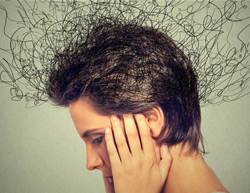The body positivity movement has more women than ever embracing their shape at any size, but eating disorders are still more common than you might guess. Around 4% of Australians are currently experiencing eating disorders like anorexia or bulimia affect.
An eating disorder is a mental disorder that involves a persistent pattern of unhealthy eating behaviour, says psychologist Dr Rebecca Pearl. “People with eating disorders experience intense distress about eating,” says Pearl. “They may also fixate on food, weight, and shape.”
Women are twice as likely as men to develop an eating disorder. “In Western society, thinness in women is often reinforced and rewarded, and is equated with beauty and success,” says nurse Ariana Chao. “These cultural pressures are often higher among women than men, which may lead to greater awareness and internalisation of a thin ideal.”
The Diagnostic and Statistical Manual of Mental Disorders, Fifth Edition (DSM-5) recognises three main eating disorders. Here's what you should know about symptoms, diagnosis, and treatment for each.
Anorexia nervosa

About 1 percent of Australians will suffer from anorexia nervosa in their lifetimes.
What is it? Anorexia nervosa is characterised by eating much less food than what the body needs to maintain normal weight and physiology. That low food intake is paired with thoughts and feelings that get in the way of maintaining a normal weight (like a hyper-critical voice constantly telling you that you’re not good enough) even though you are already living at significantly low body weight.
Who gets it? Although anorexia and other common eating disorders typically present in teenagers and young adults, women can still face anorexia later in life, so it’s important to recognise when your behaviour starts to cross over into potentially dangerous territory.
Warning signs: A person may also have anorexia if they exhibit severe weight loss, deny feeling hungry or make an excuse not to eat, exercises excessively, withdraws from social situations, or gets worried about eating in public. “It’s worrisome when someone avoids social meals, or cannot enjoy a piece of birthday cake or special holiday treats within moderation,” says psychiatrist Dr Jennifer Derenne.
Women with anorexia are more likely to commit suicide or face lethal complications from starvation.
Because of the lack of food intake and critically low body weight, anorexia can be fatal. “Physical signs and symptoms of anorexia nervosa prove dangerous, and it is an illness with the highest rates of death of any of the psychiatric illnesses that we see,” says eating disorder specialist Dr Evelyn Attia. That’s because the condition affects your hormones, bone health, heart function, skin, hair, blood cell counts, and more.
Bulimia nervosa

About 2.9% percent of Australians will suffer from bulimia at some point in their lifetimes, making it slightly more common than anorexia.
What is it? Bulimia nervosa presents itself in episodes of binge (or out-of-control) eating followed by purging through self-induced vomiting or laxative or diuretic abuse, says psychologist Dr Loren Gianini.
Who gets it? Although researchers don’t know for certain what causes eating disorders, biological factors and your surroundings do play a role-and they often start off as being what most of us view as normal dieting behaviour. “When someone develops bulimia nervosa, there’s commonly some initial attempt to control eating or reduce weight,” says Dr Attia. But in those affected by bulimia nervosa, this restriction ultimately leads to a binge eating episode followed by a frantic attempt to “undo” that out-of-control eating.
Warning signs: Those with bulimia nervosa are typically at an average weight, or even slightly overweight. Some of the most common signs include dental problems, swollen glands in their neck and jaw, and calluses on the back of the hands from self-induced vomiting, says Chao. Other red flags include skipping meals, disappearing after eating, hiding food in strange places, obvious weight fluctuations, or even self-injury.
Binge eating disorder

Binge eating is the most common eating disorder in Australia, with around 6 percent of Australians developing the condition at some point in their lifetimes.
What is it? Binge eating disorder is where a person engages in out-of-control eating that’s not appropriate for a given situation. “It can’t be making a decisions with college dorm mates to order a pizza in the middle of the night,” says Dr Attia. “Everyone’s doing that together. It might be a large amount of food, but there’s an appropriateness to the situation, and there usually isn’t a feeling of loss of control.”
When someone has a binge eating episode, on the other hand, it’s accompanied by incredibly negative feelings like shame and guilt along with a loss of control. “They really feel like a ball has started rolling down a hill, and they cannot interrupt the momentum of that ball,” says Dr Attia. But unlike bulimia, binge eating isn’t followed by purging behaviours like vomiting.
Who gets it? Those with binge eating disorder are typically overweight or even obese, but people with a normal weight can also suffer from it. Oftentimes, other mental health issues are brewing underneath the surface, since overeating can be used as a way to cope with other difficult-to-control emotions, like depression, anxiety, or stress.
Warning signs: Some of the signs of binge eating disorder include eating in secret, hiding food or food wrappers, eating faster than usual, and eating to the point of discomfort, says Chao. As with all of the other eating disorders, a person with binge eating disorder might become so preoccupied with food and weight that it impacts their ability to concentrate on other things, like their relationships and social interactions.
How are eating disorders treated?
The end game will always be to get the person’s eating habits back on track. “The goals in treating eating disorders are to normalise eating, get nutritionally rehabilitated if underweight, reduce maladaptive behaviours like excessive exercise, and work on reducing the importance of shape and weight in how someone judges themselves,” says Gianini.
For each disorder, treatments are tailored to change the behaviors of the person with that disorder, commonly through methods like cognitive behavioral therapy paired with regular nutritionist and physician care. If those treatment methods don’t work, some patients might require inpatient 24-hour treatment, where they’re monitored and reintroduced to normal eating behaviors.
If you believe you are struggling with an eating disorder and need support or more information, call the Butterfly Foundation at 1800 33 4673.



.jpg&h=90&w=90&c=1&s=1)






